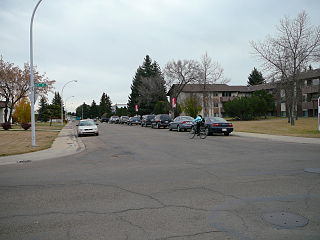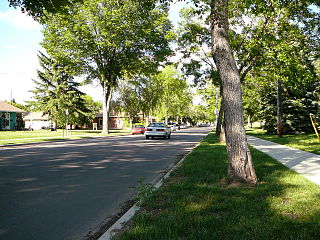Mayfield is a neighbourhood in west Edmonton, Alberta, Canada named for famed Canadian aviator and bush pilot Wop May.

West Jasper Place is a residential neighbourhood in west Edmonton, Alberta, Canada. Originally part of the Town of Jasper Place, West Jasper Place became a part of Edmonton when Edmonton and Jasper Place amalgamated on August 17, 1964.

Britannia Youngstown is a residential neighbourhood in west Edmonton, Alberta, Canada. Originally part of the Town of Jasper Place, it became part of Edmonton when Jasper Place amalgamated with Edmonton in 1964.
West Meadowlark Park is a residential neighbourhood in west Edmonton, Alberta, Canada located just east of West Edmonton Mall. The area was originally part of the Town of Jasper Place, and became a part of Edmonton when Jasper Place amalgamated with Edmonton in 1964.
Sherwood is a small neighbourhood in west Edmonton, Alberta, Canada. Originally part of the Town of Jasper Place, it became a part of Edmonton when Jasper Place amalgamated with Edmonton in 1964.

Glenwood is a large neighbourhood in west Edmonton, Alberta, Canada. The neighbourhood has a mixture of residential and commercial development. Glenwood became a part of Edmonton in 1964, when the Town of Jasper Place amalgamated with Edmonton.
High Park is a neighbourhood in west Edmonton, Alberta, Canada. The neighbourhood became a part of Edmonton when the Town of Jasper Place amalgamated with Edmonton in 1964.

Greenfield, formerly known as Petrolia, is a residential neighbourhood located in southwest Edmonton, Alberta, Canada. There is a small shopping centre, Petrolia Shopping Centre, located in the neighbourhood. The neighbourhood was named for Herbert Greenfield, the Premier of Alberta from 1921 to 1925, during the reign of the United Farmers of Alberta political party.
Eastwood is a residential neighbourhood in north central Edmonton, Alberta, Canada. It is one of Edmonton's older neighbourhoods, with development starting in 1906. Today, most of the residential construction (88%) dates from after World War II.

Holyrood is a residential neighbourhood in the Bonnie Doon area of south east Edmonton, Alberta, Canada. The name, Holyrood, is an anglicisation of the Scots haly ruid.

Idylwylde is a residential neighbourhood in south east Edmonton, Alberta, Canada.
Kenilworth is a residential neighbourhood in south east Edmonton, Alberta, Canada located just to the north of Whyte Avenue.
Terrace Heights is a roughly triangle-shaped residential neighbourhood in south east Edmonton, Alberta, Canada.
Allendale is a residential neighbourhood located in south west Edmonton, Alberta, Canada. The neighbourhood is named for the Allen family, who owned a farm there. It was annexed by the City of Strathcona in 1907.

Empire Park is a residential neighbourhood in southwest Edmonton, Alberta, Canada. A major shopping centre, Southgate Centre, is located at the west end of the Neighbourhood.
Fulton Place is a residential neighbourhood in east Edmonton, Alberta, Canada. It is named for the creek which runs along the neighbourhood's west boundary. It is part of a broader area of surrounding communities known as Greater Hardisty.
Rosslyn is a residential neighbourhood in north west Edmonton, Alberta, Canada. The neighbourhood has good access to shopping services at Northgate Centre and North Town Mall.
Lauderdale is a residential neighbourhood in north west Edmonton, Alberta, Canada. It is named for "James Lauder who farmed and owned land near the neighbourhood before the turn of the 20th century".
Killarney is a residential neighbourhood located in north east Edmonton, Alberta, Canada. While the area became part of Edmonton in 1913, residential development did not occur until the 1950s and 1960s.

Queen Alexandra is a mixed residential and commercial neighbourhood in south west Edmonton, Alberta, Canada. The neighbourhood, once part of the City of Strathcona, is named for Alexandra of Denmark. The north edge of the neighbourhood, along Whyte Avenue is part of Old Strathcona, a popular commercial and cultural area of Edmonton.








